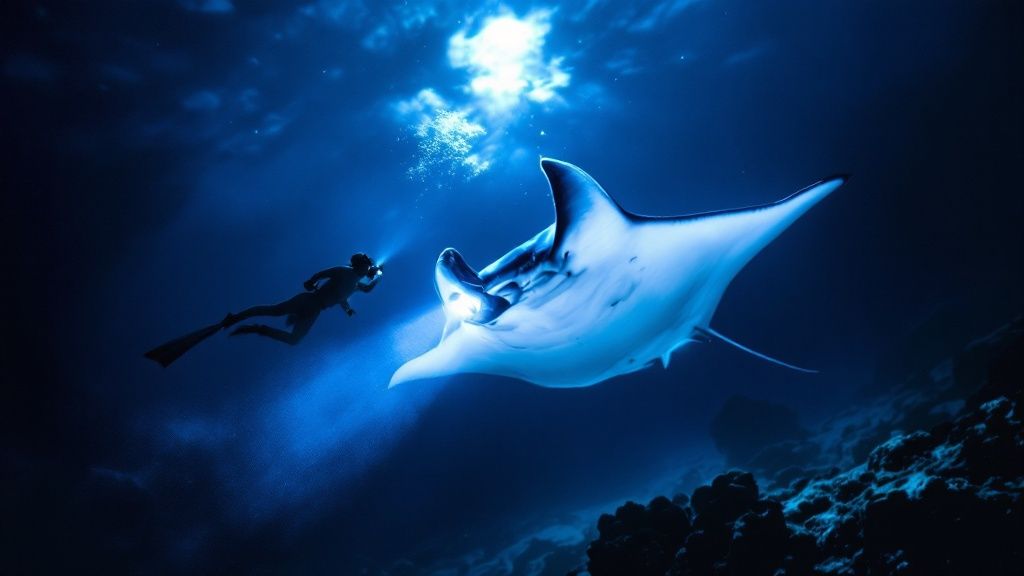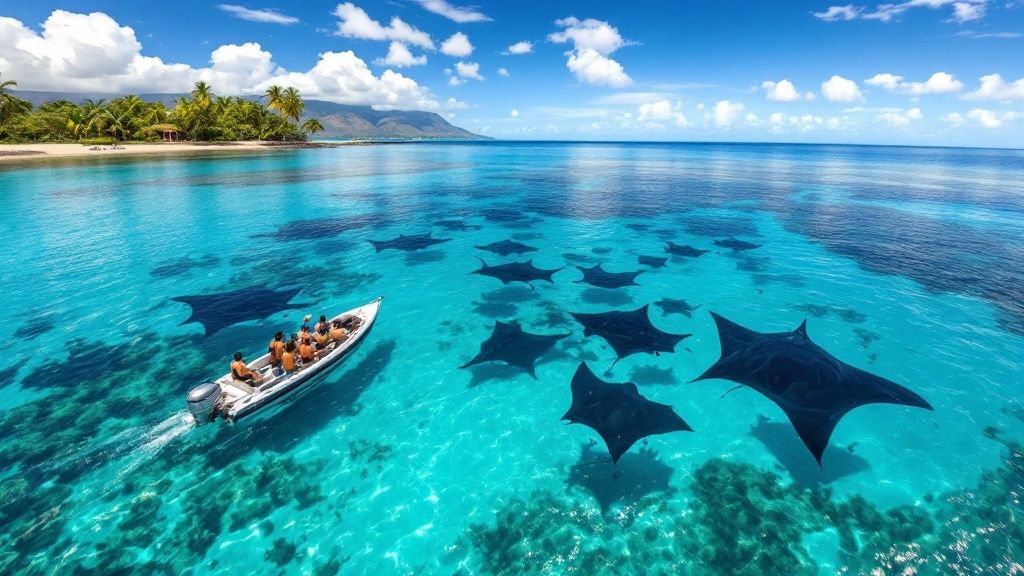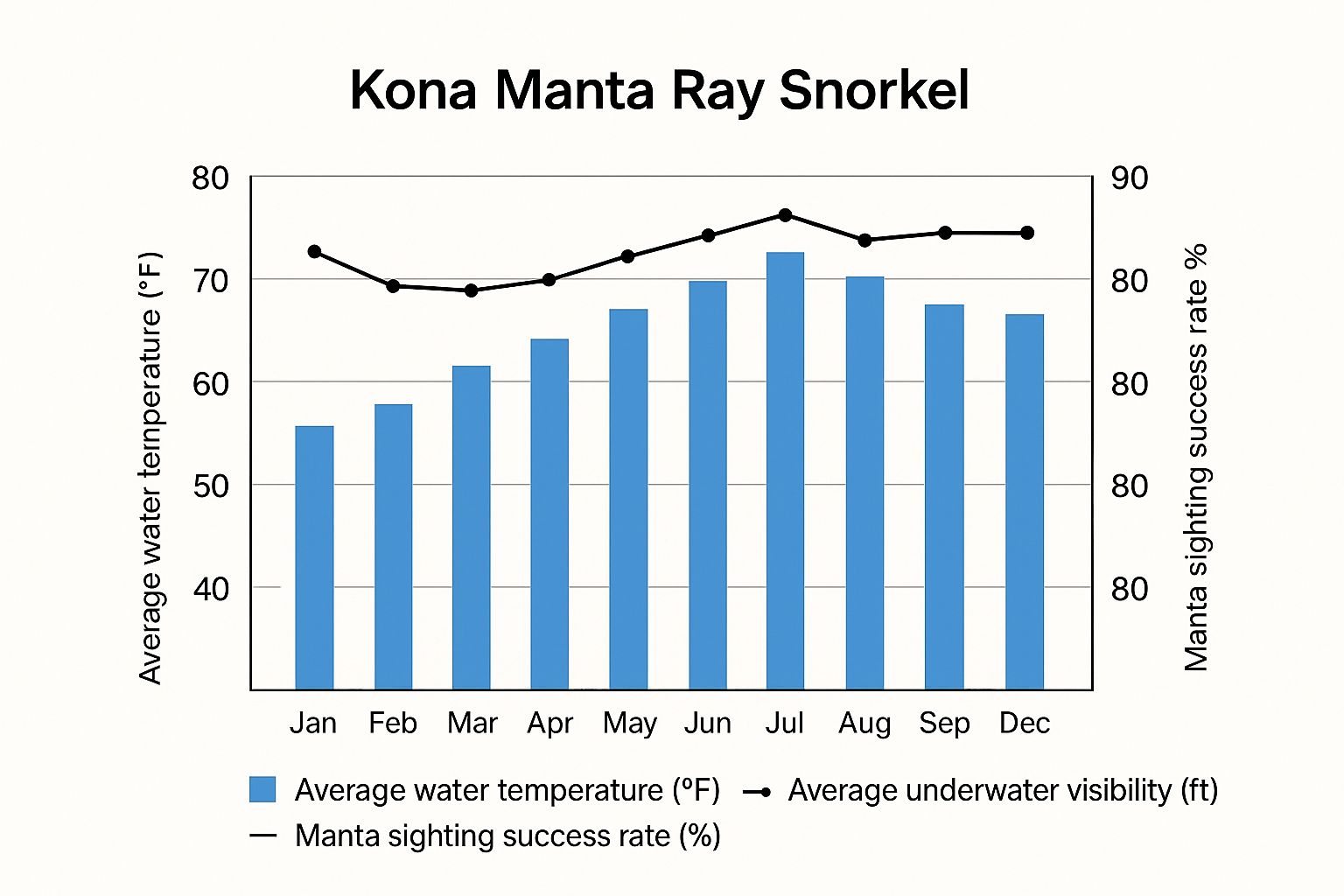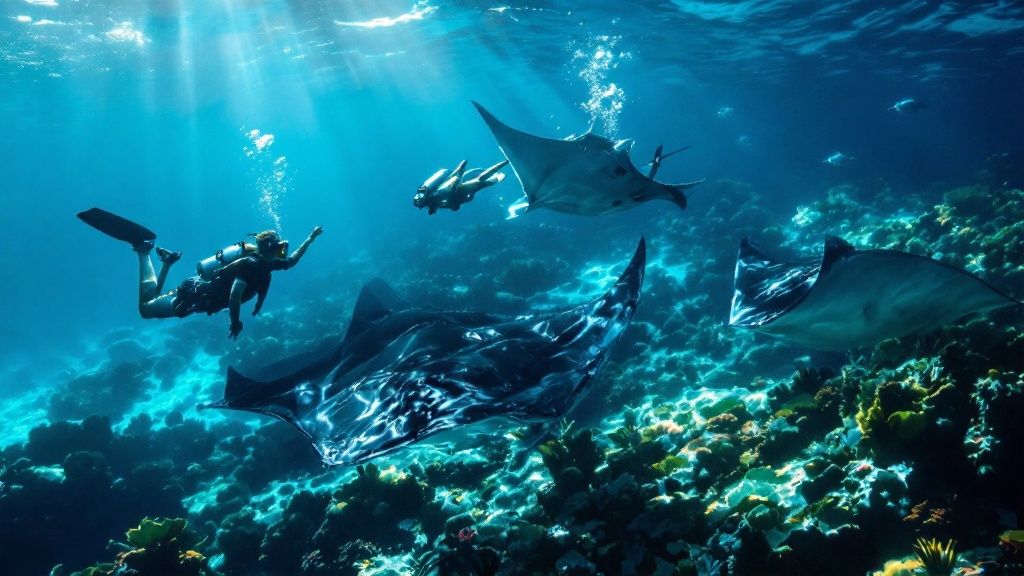Manta Ray Snorkel Kona | Experience Hawaii’s Best Underwater Adventure
- Byron
- Apr 30
- 10 min read
The Magic of Manta Ray Encounters in Kona Waters

Floating in the inky blackness of Kona's waters, illuminated by the gentle glow of underwater lights, is a truly captivating experience. Watching these massive, graceful manta rays glide beneath you is nothing short of breathtaking. This unique encounter consistently ranks as one of Hawaii's most awe-inspiring wildlife experiences, drawing visitors worldwide.
The Gentle Giants of the Deep
Manta rays, sometimes confused with stingrays, are actually gentle filter feeders. Their diet consists mainly of plankton, microscopic organisms thriving in Kona's nutrient-rich waters. With wingspans reaching up to 14 feet, these gentle giants possess an ethereal beauty, performing acrobatic feeding loops that create a mesmerizing spectacle. Unlike other wildlife encounters where observation might be from a distance or through enclosures, the interaction with manta rays in Kona is intimate and personal.
Kona: A Manta Ray Paradise
Kona’s unique underwater environment provides the perfect setting for these unforgettable interactions. Sheltered bays and coves, created by the volcanic topography, offer ideal feeding grounds for the manta rays and calm waters for snorkelers. Kona, Hawaii boasts incredibly high success rates for manta ray sightings, between 80% and 90% year-round. This consistency is due to predictable feeding patterns, drawing the rays to plankton-rich areas like Manta Village and Manta Heaven. For more detailed statistics, check out the Jack's Diving Locker Manta Ray Report. This remarkable statistic solidifies Kona’s status as a premier destination for manta ray snorkel adventures. You can also explore Our Blog Post Sitemap for related content.
A Spiritual Connection
For many Hawaiians, the manta ray, known as Hahalua, carries deep spiritual significance. Often seen as messengers from the gods, they embody wisdom and grace. This cultural reverence adds another layer of depth to the Kona manta ray experience. It transforms a simple wildlife encounter into something profoundly moving and spiritual. This unique cultural aspect, rarely found in other wildlife tourism, fosters a deep appreciation for both the animals and the local Hawaiian culture.
Prime Locations: Where the Magic Happens

Kona, Hawaii, offers two truly special spots for incredible manta ray encounters: Manta Village and Manta Heaven. Each location provides a distinct experience, ensuring an unforgettable adventure for every snorkeler.
Manta Village: The Keauhou Bay Gem
Nestled in the calm waters of Keauhou Bay, Manta Village is a fantastic option for families and those new to snorkeling. The bay's sheltered nature creates a tranquil setting, perfect for younger children or less confident swimmers. Plus, its proximity to the shore means shorter boat trips, reducing travel time and minimizing the chance of seasickness. The unique underwater topography of the bay acts like a natural amphitheater, concentrating plankton and drawing in the magnificent manta rays.
Accessibility: Short boat rides, close to shore.
Water Conditions: Calm and protected.
Ideal For: Families and beginners.
Manta Heaven: An Intimate Garden Eel Cove Experience
For a more secluded adventure, Manta Heaven in Garden Eel Cove is the perfect choice. While the waters can be a bit more active compared to Manta Village, this site often sees fewer tour boats. This allows for a more personalized and up-close encounter with the manta rays. The deeper waters and distinct currents of Garden Eel Cove attract diverse marine life, adding to the overall snorkeling experience.
Accessibility: Slightly longer boat rides, further offshore.
Water Conditions: Can be choppier, deeper water.
Ideal For: Experienced snorkelers seeking a more intimate encounter.
To help you choose the right spot, here's a comparison of the two locations:
Manta Ray Snorkel Locations Comparison
Feature | Manta Village (Keauhou Bay) | Manta Heaven (Garden Eel Cove) |
|---|---|---|
Location | Keauhou Bay | Garden Eel Cove |
Water Conditions | Calm and sheltered | Can be choppier, deeper waters |
Accessibility | Close to shore, short boat rides | Further offshore, slightly longer boat rides |
Crowd Level | Often more tour boats | Typically fewer tour boats |
Ideal For | Families, beginners | Experienced snorkelers, smaller groups |
This table highlights the key differences between the two prime manta ray viewing locations, allowing you to make an informed decision based on your preferences and experience level.
Choosing Your Perfect Manta Ray Adventure
Ultimately, the "best" location depends on your individual needs and desires. Manta Village offers a relaxed and easily accessible experience, while Manta Heaven provides a more adventurous and intimate encounter. Consider your comfort level in the water and your desire for a personalized experience. For those looking for additional details, the Site Map offers a wealth of information about various aspects of the tours. No matter which location you choose, Kona's manta rays promise an unforgettable experience.
Perfect Timing: Seasons and Conditions for Success
Timing is key when planning your manta ray snorkel Kona adventure. Understanding Kona's seasonal coastal water conditions can greatly increase your chances of an amazing encounter. Water clarity, ocean swells, and the amount of plankton all influence your manta ray viewing experience.
Seasonal Variations and Their Impact
Manta rays grace Kona's waters throughout the year, but certain seasons provide better conditions. The dry season, from April to October, typically has calmer waters and improved visibility. This period also aligns with peak plankton blooms. This creates a feeding frenzy for manta rays, increasing your chances of seeing their captivating feeding rituals. The summer months (June through August) often have the clearest waters. However, this is also the busiest time for tourists, so booking your manta ray snorkel Kona tour in advance is crucial.
Conditions can vary, and comparing ideal times with general snorkeling conditions in other locations can be helpful. For example, the marathon key snorkeling resource offers insights into Florida Keys conditions.
The Allure of Night Snorkeling
Night excursions offer a completely different, and arguably more spectacular, experience compared to daytime snorkeling. Under the cover of darkness, special lights attract plankton, bringing the manta rays closer to the surface. This creates an ethereal underwater ballet as the rays perform graceful loops and spirals right below you. The darkness also amplifies the bioluminescent plankton, adding a touch of magic to the already mesmerizing scene. Historical data on manta ray sightings provides valuable insights into their behavior. From 2009 to 2014, detailed records documented individual manta rays, their health, and their appearances at specific locations. Learn more about manta ray statistics.
Maximizing Your Chances of Success
Consider traveling during the shoulder seasons (April-May or September-October) for a good balance of favorable conditions and fewer crowds. Booking your tour earlier in your trip is also a good strategy. Many operators offer a “manta ray guarantee,” allowing you to reschedule without charge if your initial trip doesn't result in any sightings.
Understanding Seasonal Trends: A Visual Guide
The following data chart illustrates typical monthly variations in manta ray sighting success rates, average number of mantas encountered, water visibility, and general ocean conditions in Kona.
Month | Sighting Success Rate | Average Number of Mantas | Water Visibility | Ocean Conditions |
|---|---|---|---|---|
January | 85% | 8 | Moderate | Can be choppy |
February | 88% | 10 | Moderate | Can be choppy |
March | 90% | 12 | Good | Generally calm |
April | 92% | 15 | Excellent | Calm |
May | 95% | 18 | Excellent | Calm |
June | 92% | 15 | Excellent | Calm |
July | 90% | 12 | Excellent | Calm |
August | 88% | 10 | Excellent | Calm |
September | 85% | 8 | Good | Generally calm |
October | 82% | 6 | Moderate | Can be choppy |
November | 80% | 5 | Moderate | Can be choppy |
December | 82% | 6 | Moderate | Can be choppy |

As the data chart shows, while sighting rates remain consistently high throughout the year, the average number of manta rays peaks during May-June. Water visibility is generally best during the summer, coinciding with calmer ocean conditions. This data underscores the importance of considering these factors when planning your manta ray snorkel Kona trip. For more planning tips, explore the Our Blog Category Sitemap.
Selecting Your Perfect Manta Ray Experience
With so many manta ray tour operators in Kona, choosing the best one can feel a little daunting. Careful research is key to having a truly amazing experience. This guide will help you find the perfect operator, turning your manta ray snorkel Kona adventure into a memory you'll cherish forever.
Key Questions to Ask Potential Operators
Finding the perfect manta ray snorkel Kona tour starts with asking the right questions. Reach out to operators directly and ask about these important factors:
Group Size: Smaller groups often translate to more personalized attention from the guides. This can be especially beneficial for first-time snorkelers, allowing for a more enriching experience.
Guide Experience: Ask about the guides' experience and their knowledge of manta rays. Knowledgeable guides can offer fascinating insights into manta ray behavior, enhancing your understanding of these incredible creatures.
Sustainability Practices: It's important to choose an operator committed to sustainable tourism. Ask about their practices and how they prioritize manta ray welfare and minimize their impact on the delicate marine environment.
Equipment Provided: Confirm that the operator provides all the necessary snorkeling gear, including wetsuits, masks, and snorkels. Some operators also offer underwater cameras or photography packages.
Contingency Plans: Find out what happens if mantas aren't sighted on your tour. Reputable operators often offer a "manta guarantee," giving you the opportunity to reschedule your tour free of charge.
Red Flags to Watch Out For
While most operators strive to provide exceptional experiences, it's wise to be aware of these potential red flags:
Overcrowded Boats: A crowded boat can negatively impact your experience, making it harder to observe the manta rays and interact with the guides.
Lack of Safety Briefings: A comprehensive safety briefing is essential before entering the water, particularly at night. Operators who skip this crucial step might be compromising your safety.
Disregard for Manta Ray Welfare: Pay attention to how the guides and staff interact with the manta rays. Any behavior that appears to disturb or harass the animals should be a serious concern.
Negative Reviews: Before booking, take the time to read online reviews from previous customers. Negative reviews concerning guide behavior, boat conditions, or the overall experience warrant further investigation.
Tailoring Your Experience: Special Considerations
Choosing the right tour also means considering your individual needs and preferences:
Families with Children: Look for operators catering to families, offering child-friendly equipment and experienced guides comfortable working with younger children. Manta Village, with its calmer waters, is often a great choice for families.
Non-Swimmers: Some operators offer alternative viewing options from the boat for those who prefer not to snorkel.
Photography Enthusiasts: Ask about photography packages or bring your own underwater camera to capture stunning images of these magnificent creatures. Check out this resource: How to master underwater photography for the best manta ray shots.
Mobility Concerns: Discuss any mobility issues with the operator in advance. Some boats may have limited accessibility.
Choosing Wisely for an Unforgettable Adventure
By asking the right questions, watching for potential red flags, and tailoring your experience to your specific needs, you can ensure a truly memorable manta ray snorkel Kona adventure. The goal isn't just to see manta rays, but to connect with them in a meaningful and responsible way. Selecting a reputable operator and understanding your personal needs will significantly contribute to a breathtaking and educational experience. Your Manta Ray Night Snorkel will be an adventure you'll never forget.
The Full Experience: What Really Happens Underwater

From the moment you board the boat for your manta ray snorkel Kona adventure, excitement hangs in the air. This section walks you through the entire journey, from check-in to the magical moment you encounter a giant manta ray in the dark ocean.
Preparing for the Dive
Your adventure begins with a thorough safety briefing and overview of the experience. You'll learn about the specialized equipment, including the wetsuit, mask, snorkel, and the powerful underwater lights. These lights, placed on a floating platform, attract plankton, the manta rays' primary food source.
Entering the Water
Next, you'll enter the dark ocean. While this might seem intimidating, flotation devices, often pool noodles, help you stay afloat and minimize movement. This allows you to focus on the incredible underwater world. Guides are always present to ensure your safety and offer assistance.
The Manta Ray Ballet
Floating in darkness, surrounded by the gentle ocean currents and the glow of underwater lights, creates a truly unique atmosphere. The manta rays, drawn by the plankton, glide through the illuminated water. These gentle giants, with wingspans sometimes exceeding 10 feet, perform mesmerizing feeding loops and spirals, often coming incredibly close. This close encounter creates a sense of wonder and a deep connection with these magnificent creatures.
Addressing Common Concerns
Many people have questions about nighttime ocean snorkeling. Some worry about seasickness, but most tours offer short boat rides to minimize this. Guides are also trained to handle choppy conditions. For more information, you can visit Our Blog Post Sitemap. Even if the manta rays are less active, the experience of floating under the stars, surrounded by bioluminescent plankton, is still memorable. The guides prioritize safety, ensuring a secure and enjoyable experience.
The Sensory Experience
The entire experience is a sensory feast. The cool water, the gentle rocking of the ocean, and the play of lights create a truly immersive experience. The feeling of vulnerability and wonder, as these massive yet gentle creatures glide so close, is unforgettable. The manta ray snorkel Kona adventure is more than just a wildlife encounter; it's a profound connection with nature.
Insider Secrets: Transforming Good to Unforgettable
The difference between simply seeing manta rays and having a truly unforgettable experience often lies in the details. This section, drawing on insights from experienced photographers, marine biologists, and Kona's veteran manta ray guides, reveals the secrets to elevating your manta ray snorkel Kona adventure.
Enhancing Your Comfort and Warmth
While Kona's waters are generally pleasant, extended time in the ocean, especially at night, can lead to chills. Wearing a thin rashguard or thermal layer under your wetsuit can significantly improve your comfort and warmth. This extra layer traps a thin layer of water against your skin, which your body heats, creating an insulating effect.
This allows you to fully focus on the manta rays without being distracted by the cold. Additionally, consider wearing a neoprene cap. A significant amount of body heat is lost through the head, and a cap will help you stay comfortable throughout the snorkel.
Mastering Underwater Photography Techniques
Capturing stunning images of these gentle giants in challenging low-light conditions requires some knowledge. Many photographers recommend using a fast lens with a wide aperture (f/2.8 or wider) to maximize light intake. Increasing your camera’s ISO setting can also brighten your images, but be mindful of noise at higher ISO values.
A red filter can help correct color distortion caused by the water and artificial lights, resulting in more vibrant and accurate photos. Remember to keep your camera securely attached to a float or wrist strap – and, as always, avoid touching the manta rays with your camera or any other equipment.
Positioning for Optimal Viewing
Your position in the water significantly impacts your viewing experience. Instead of actively chasing the manta rays, which can disrupt their natural behavior, position yourself near the bottom and maintain a still, respectful distance.
The manta rays, attracted by the plankton around the lights, will naturally glide and spiral above you, offering incredible viewing opportunities. This passive approach not only enhances your experience but also minimizes your impact on these magnificent creatures.
Breathing Techniques for Extended Floating
Staying relaxed and comfortable while floating requires conscious breathing. Practice slow, deep breaths, inhaling through your nose and exhaling through your mouth.
This controlled breathing helps regulate your buoyancy and conserves energy, allowing you to fully immerse yourself in the experience without feeling strained.
Pre-Trip Preparation for Peak Performance
Preparing for your manta ray snorkel Kona adventure begins before you even arrive in Hawaii. Light exercise and stretching in the days leading up to your trip can improve your flexibility and stamina in the water. Staying hydrated is crucial, especially in Kona’s tropical climate.
If you’re prone to seasickness, consult your doctor about appropriate medication and consider taking it well before your tour. These simple pre-trip preparations can significantly enhance your comfort and enjoyment, ensuring you're physically and mentally ready to fully appreciate this extraordinary experience.
Ready to experience the magic of manta rays in Kona? Book your unforgettable Manta Ray Night Snorkel Kona Hawaii Tours today!
Comments